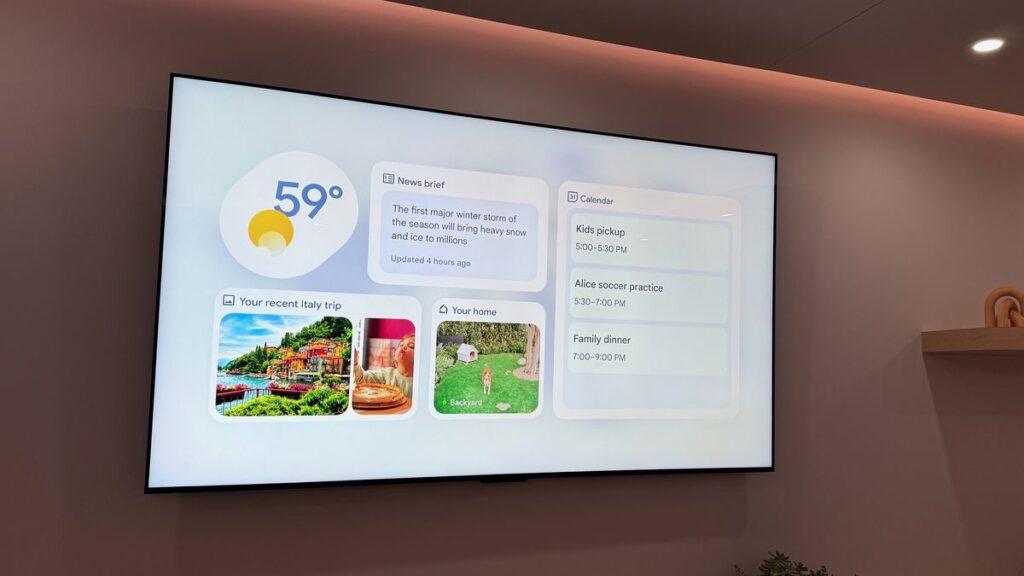- Google announced the next generation of Google TV at CES 2025.
- You are receiving a strong infusion of Gemini to enhance your intelligence and improve your conversational skills.
- Additionally, with proximity sensors, it has a unique version of “Ambient Mode”.
The Google TV platform powers not only the Google TV Streamer box, but also countless televisions that choose to be the native operating system of choice. As a successor to Android TV, it introduced a cleaner interface with better recommendations for major streaming services (as well as support for more of them) and a hefty dose of voice control, courtesy of ‘Hey Google.’
Now, however, like many of the other announcements at the 2025 Consumer Electronics Show, Google is giving us a look at the next generation of Google TV, and of course, it has a tie-in to AI. Like the latest Pixel phones, the next-generation Google TV will feature Gemini and, importantly, will allow for much more natural conversation requests.
Additionally, when the next-generation Google TV devices are expected to arrive by the end of 2025, it will be a combination of software and some hardware to enable an ambient experience that almost feels self-aware. Thanks to proximity sensors in upcoming TVs, you can automatically turn the TV on to a photo gallery slideshow when you enter the room, but then switch to a dashboard of sorts as you get closer. Very good, right?
This is certainly Google TV’s version of the ambient experience, one that mimics the Nest Hub and Nest Hub Max or even the latest Nest Thermostat, as it adjusts the content displayed depending on where you are in the space. The look of the photo gallery, which includes a subscription option for images created through Generative AI, is reminiscent of both the Chromecast’s static pages and art TVs like Samsung’s Frame or Hisense’s Canvas TV.
So the requirement for this environment will apparently be a proximity sensor on the televisions, but I imagine that as we get closer to viewing them, there might be a way to activate this board via the remote control; that ultimately remains to be seen. But just like a smart speaker or display, these next-generation Google TVs will have built-in far-field microphones to let you make truly unlimited queries to Gemini or “Hey Google.”
However, since it’s a big screen, Google is optimizing and tweaking the Gemini LLM a bit so that in addition to answering a question like how big is our galaxy or asking you to plan a trip, it can suggest YouTube videos to access and Learn more about the screen. answers (or responses). As we’ve seen with other AI-powered assistants, it’s all about customizing that power based on the device you’re receiving it on.
We are covering all the latest news. CES news of the program as it happens. Stay with us for the big stories on everything from 8K From foldable TVs and screens to new phones, laptops, smart home devices and the latest in artificial intelligence.
And don’t forget follow us on tiktok To find out the latest from the CES fair!
Of course, since it’s Google TV and works with many Google services, you’ll also be able to control smart home devices and even run automation. Unlike Google Assistant, you’ll be able to speak more like a human and in more conversational terms rather than the more rigid voice prompts of the past.
This also applies when you ask for help finding something to watch; You can be as specific as a Disney animated movie appropriate for all ages or something much broader for suggestions. As we saw with Google TV Streamer, Gemini will summarize key reviews and feelings about the selected title when you open a movie.
From a first glance, it’s a nice AI advancement for Google TV as a platform, but of course it all comes down to hardware partners. While we already have an idea of what TV manufacturers have already opted for, it remains to be seen where this next-generation experience will be found, but it is announced that we will see them arrive on future hardware in late 2025.
It’s also worth noting that since there’s an additional requirement for far-field microphones and proximity sensors, this likely won’t make it to the current Google TV Streamer. Who knows, Google may be preparing a hardware package.




